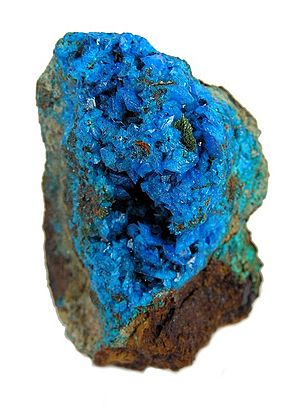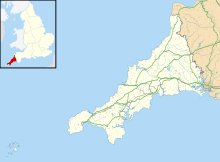Wheal Gorland facts for kids

Liroconite from Wheal Gorland, its type locality
|
|
| Location | |
|---|---|
| Location | St Day |
| County | Cornwall |
| Country | England |
| Coordinates | 50°14′30″N 5°11′02″W / 50.2417°N 5.1839°W |
| Production | |
| Products | Copper, tin, arsenic and tungsten |
| History | |
| Opened | 1792, 1906 |
| Closed | 1864, 1909 |
Wheal Gorland was an important mine in Cornwall, England. It was located near the village of St Day. This mine was famous for digging up metals like copper and tin. It was also special because many rare copper minerals were found there. These minerals formed due to natural processes in the ground. Wheal Gorland is the first place where five specific minerals were discovered. These minerals are chenevixite, clinoclase, cornwallite, kernowite, and liroconite.
Contents
Mine History and Production
The amount of metal Wheal Gorland produced changed a lot over time. This was because the rich areas of ore were spread out. In 1833, a writer named George Abbot said the mine had made over £300,000 in profit. It produced 1,400 tons of ore each year. At that time, it was the third most profitable mine in Cornwall. Only Dolcoath mine and Consolidated Mines made more money.
However, by 1865, things had changed. Another writer, Thomas Spargo, noted that Wheal Gorland was no longer active. It had become part of a larger group of mines called St. Day United.
Early Operations and Discoveries
In the early 1790s, Wheal Gorland connected to the Great County Adit. This was a very long tunnel system that helped drain water from many mines. The mine's own smaller tunnels were changed to also drain into this deeper system.
Records show what the mine produced between 1815 and 1851. It dug up 40,750 tons of copper ore. This ore was about 7.5% pure copper. The mine also produced 15 tons of black tin and 18 tons of arsenic. A lot of fluorspar was also found. People even said that gold was discovered in the iron-rich rock near the surface, called gossan.
Later Years and Reopening
In 1852, a group of mines called St. Day United took over Wheal Gorland. It became the main place for keeping the Great County Adit working. But by 1864, the mine was completely closed down.
Wheal Gorland reopened in 1906. A company named Edgar Allen and Company started working there again. They dug through old tunnels and piles of waste rock. They were looking for tin and tungsten ores. Before closing for good in 1909, the mine sold 164 tons of tungsten ore. It also sold 18 tons of black tin.
Special Site for Minerals
Since 1988, the Wheal Gorland site has been a Site of Special Scientific Interest. This means it is a protected area because of its unique features. Many different kinds of lead and copper minerals have been found in the mine's waste piles. These minerals are important for scientific study.
In 2010, a report said the site was in "unfavourable declining condition." This was because bushes and plants were growing over the waste piles. This growth made it harder to dig for minerals in the future. The report also mentioned that the plants might be affecting the minerals themselves. New layers of soil forming could change the chemical processes happening in the mine waste.


